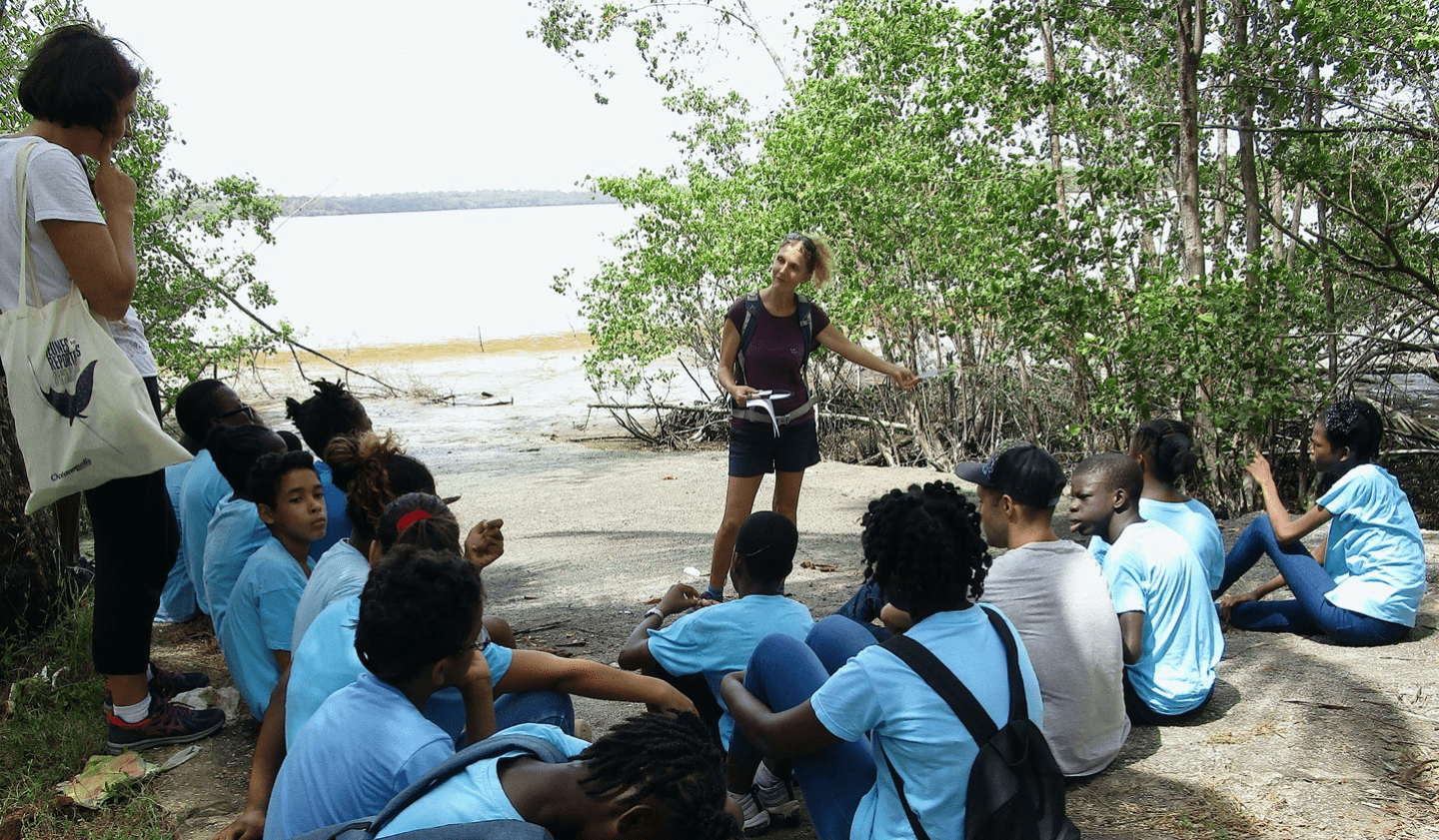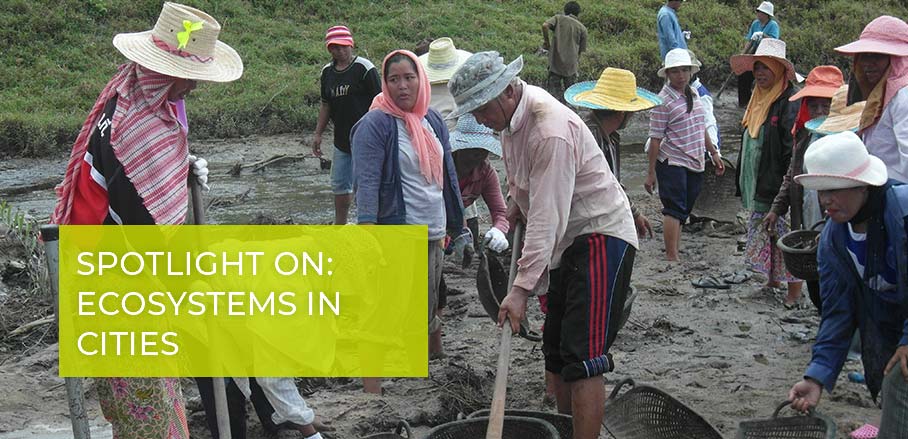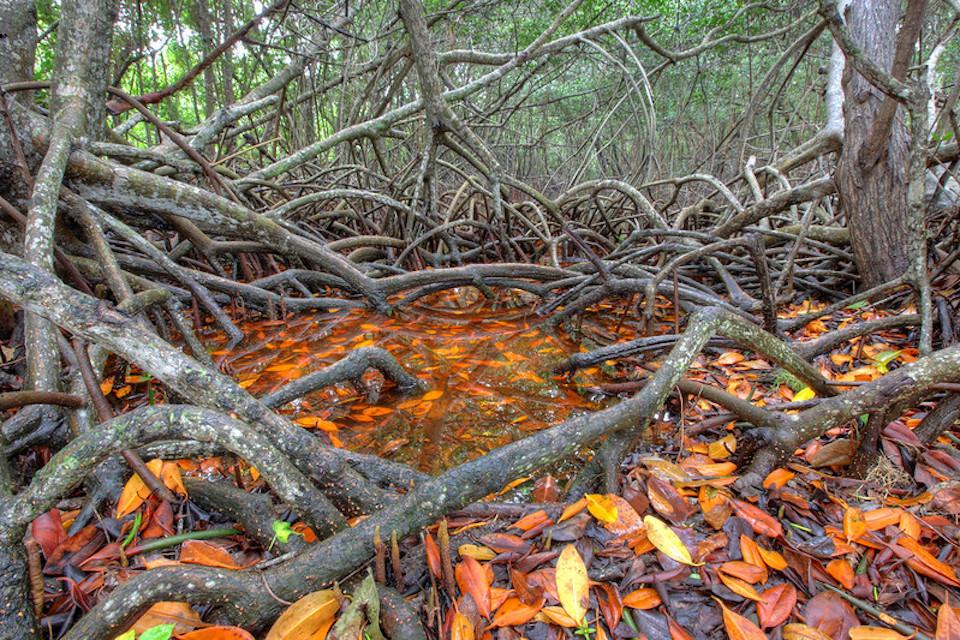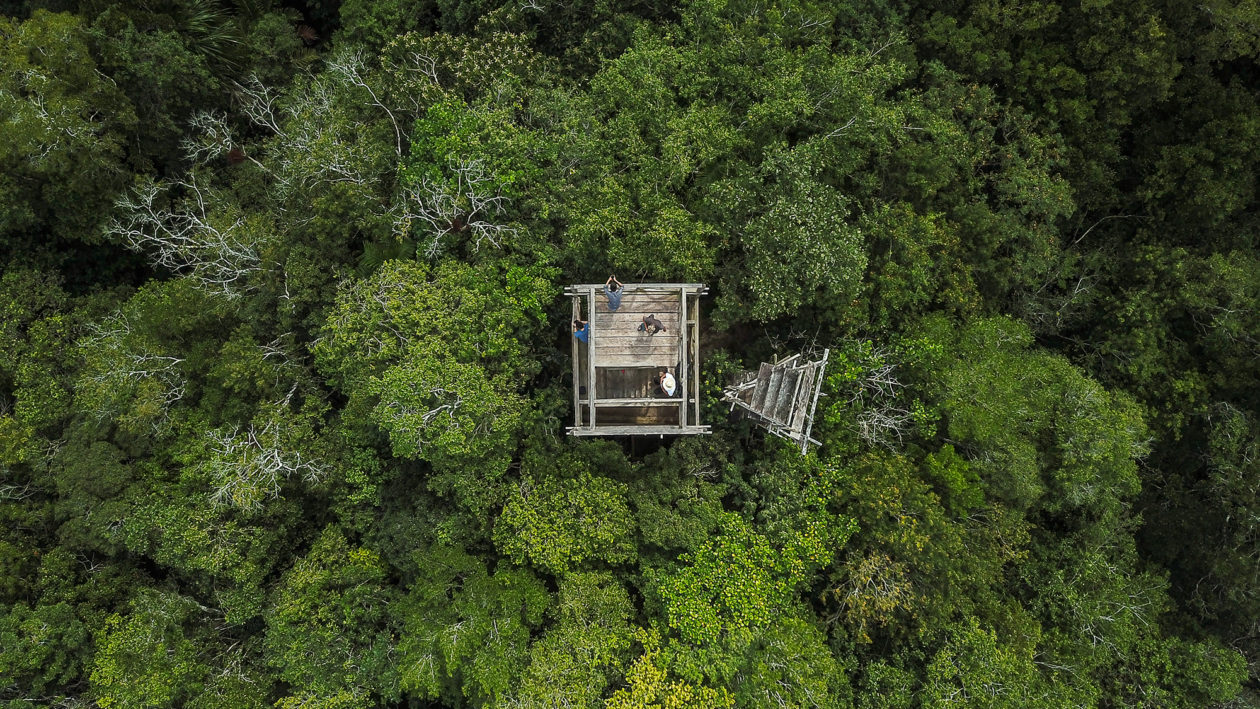FEATURE Marvellous Mangroves for French Guyana – The Mangrove Alliance

French Guyana – Merveilleuses Mangroves de Guyane, the French version of Marvellous Mangroves, adapted and translated for use in French Guyana, has just been published. The joint project between the Mangrove Action Project (MAP), Cayman Islands-based Mangrove Education Project (MEP) and Kote Foret was started in early 2018 when MAP education director and MEP executive director Martin Keeley and Kote Foret’s director Lucille Dudoignon began the process by reviewing the Dutch version from the country’s Suriname neighbour. Mr. Keeley travelled to French Guyana in 2018 as well as the following year, and in the fall of 2019 ran a three day pilot workshop with Ms. Dudoignon at the College Schoelchner school in Kourou on the coast. The workshop was supported by teachers Audrey Gardan and Remy Catel and combined their classes for several of the activities as well as the field trip held on the third day to the mangroves at Pointe de Roches in Kourou. “The pilot went extremely well,” says Mr. Keeley. “My French is a bit rough, but Lucille took over and with her teaching skills the kids participated enthusiastically in both the activities and the field trip. We had spent several days prior to the pilot reviewing the materials and their application. It takes a long while to put together a Marvellous Mangroves program in a new country, and while the ecosystem in French Guyana is essentially the same as that of Surinameen there are some differences in the flora and fauna, the translation needs to be accurate. Social styles can also be different and this can affect classroom implementation.” READ MORE GLOBAL Love mangroves? Share your pictures with the world

GLOBAL – Once again, as a celebration of International Mangrove Day on July 26, they are raising awareness of the importance of mangrove forests with a global photography contest. Following on from World Environment Day on June 5, and to celebrate the bold commitments being made across the world for a sustainable future, the theme for this year’s contest is #ForNature. We invite you to send us your best photos for a chance to be part of a special exhibition that will help highlight the beauty and importance of these undervalued coastal ecosystems. Photos will be viewed and judged by an expert panel, including photographer Cristina Mittermeier, and there will be special prizes this year for our three chosen winners. Wherever you live in the world and whether you are an amateur or professional, beginner or expert, young or old, this contest is for you. Your images have the power to inspire people and to help raise the profile of mangroves. Deadline for entries is Friday, July 24, 2020. READ MORE Addressing Climate Change Vulnerability of Coastal Cities Through Mangrove Forests

GLOBAL – Around the world, coastal cities are threatened by storms, rising sea levels, and other climate change related hazards. With conventional approaches often both costly and ineffective, nature-based solutions are offering valuable alternatives. One example are the community-based methods developed by the NGO Mangrove Action Project. The climate crisis is real and measurable. Sea levels are rising, storms and droughts are intensifying at an alarming rate. A recent study warns that major coastal cities such as Mumbai, Shanghai, Jakarta, and Bangkok could be lost to rising sea levels over the next 30 years, affecting an estimated 300 million people living along the world’s coasts. This is about three times the number of people affected than previously estimated. “The figure could double to 630 million people affected by 2100 if little is done to rein in greenhouse gas emissions. These assessments show the potential of climate change to reshape cities, economies, coastlines and entire global regions within our lifetimes,” says Scott Kulp, lead author of the study. READ MORE Mangrove Trees – Nature’s Hurricane Barriers – Could Be Gone By 2050 Due To Sea Level Rise

GLOBAL – Mangrove trees serve as nature’s hurricane barriers for places such as Everglades National Park, Biscayne National Park, Virgin Islands National Park, and Big Cypress National Preserve. Plus, they provide valuable habitat for fish and other marine life, and are pretty cool for humans who are fortunate enough to paddle through them. But they could be gone by 2050, victims of sea level rise driven by climate change. Scientists studying sediment data from the last 10,000 years are estimating that current projections for sea level rise will doom mangroves if they come true. When sea level rise rates exceeded 6 millimeters per year, similar to estimates under high-emissions scenarios for 2050, the scientists found that mangroves were very likely to stop keeping pace with the rising water levels. Mangroves are more likely to survive when sea-level rise is less than 5 millimeters (about 0.2 inches) per year, which is projected for low-emissions scenarios this century, the study published in the journal Science said. READ MORE AFRICA A Photo Essay Celebrating Africa’s Precious Biodiversity

CONGO – The food we eat, the air we breathe, the water we drink and the climate that makes our planet habitable all come from nature. During these exceptional times, nature is sending us a message: to care for ourselves, we must care for nature. It’s time to wake up. To take notice. To raise our voices. It’s time to build back better for people and the planet. Africa is immensely rich in biodiversity. Its living organisms comprise around a quarter of global biodiversity and it supports the Earth’s largest intact assemblages of large mammals, which roam freely in many countries. Africa’s biomes extend from mangroves to deserts, from Mediterranean to tropical forests, from temperate to sub-tropical and montane grasslands and savannas, and even to ice-capped mountains. In celebration of World Environment Day, we are pleased to share with you some of Africa’s unique Biodiversity. READ MORE Madagascar’s communities, an engine for change

MADAGASCAR – Local entrepreneurship drives wildlife conservation and food security. “My daughters and I, we don’t always get to eat enough,” says Nirina, a resident of the Malagasy village of Marovovonana. “There’s no supermarket here, so we mostly eat what we grow ourselves or find in the forest.” She is hopeful that the training she has been receiving in poultry rearing will improve her family’s diet and reduce the pressure on her to go hunting. Nestled in sumptuous vegetation, Marovovonana is among Madagascar’s remotest settlements. On the edge of Makira Nature Park, it sits next to one of the country’s largest tracts of virgin forest. The spot is exceptionally rich in biodiversity and a habitat for lemurs, an animal found nowhere else in the world. Conserving this unique fauna matters crucially in a community heavily dependent on fishing and hunting for its food and income. But poverty, isolation and a shortage of domestic meat have forced the inhabitants of Marovovonana and neighbouring villages to hunt down species that are endemic, endangered or at risk of extinction. In a rapidly changing world, Nirina – much like the other 90 000 people living on the edge of the nature park – struggles to make ends meet. The wildlife around her is thinning out and flooding is increasingly frequent. READ MORE AMERICA In Guatemala, Communities Take Best Care of the Forest

GUATEMALA – When the government of Guatemala created the Maya Biosphere Reserve in 1990 to protect Central America’s largest rainforest, conservationists felt betrayed that a big chunk was given to local communities for sustainable logging. They saw it as a lost chance to save the heart of the third most important biodiversity hotspot on the planet, home to more than 1,400 plant and 450 animal species, including jaguars, pumas, tapirs, spider monkeys, alligators, harpy eagles, and macaws. Today many think differently. Illegal cattle ranches — most of them linked to major drug cartels — have been wrecking the national parks containing the protected forests in the west of the reserve, causing some of the fastest rates of deforestation in the world. Almost a third of the forests in the largest park in the reserve, the 835,000-acre Laguna del Tigre National Park, has been lost since 2000. But the once-maligned community forests are still intact, a shining beacon of conservation covering nearly 900,000 acres of the eastern half of the reserve. Deforestation rates there are a fraction of 1 percent. Together, they comprise one of the world’s largest and most successful community forest experiments. READ MORE ASIA Japanese coal developers to push three new coal power stations in Bangladesh

BANGLADESH – Japanese companies are planning to build at least three new coal power plants on the small coastal island of Matarbari in Bangladesh, one of the most climate vulnerable countries in the world. If built, these three climate-wrecking coal-power stations alone would produce an estimated 506 million tonnes of carbon dioxide throughout the plants’ operational lifetimes. If global temperatures continue to rise, the impacts of climate change would be felt more strongly by Bangladesh than most other countries. We can’t let Japanese financial institutions and coal power developers: JICA, Sumitomo, NEXI and SMBC threaten our future and the future of communities in Bangladesh. We need your support. Please re-tweet and share the posts on Twitter and Facebook. Take action now and stop the build-out of coal plants in Bangladesh. LAST WORD Rest in peace, Rainforest Rescue founder Reinhard Behrend
 Dear friends of the rainforests, We have sad news to share with you today: Reinhard Behrend, the founder of Rainforest Rescue (Rettet den Regenwald e.V.), passed away on June 5, 2020, after a long battle with cancer. Fascinated by the beauty and diversity of the natural world, Reinhard built a worldwide network to defend it. With Rainforest Rescue’s campaigns, he helped sensitize the public to the issues of environmental crime and social injustice. While he knew that rainforest destruction is a juggernaut that cannot be halted easily, he never let up in his determination to stand up for the rights of rainforest dwellers and protect biodiversity. His life’s work: saving the rainforest Reinhard’s desire for us to reconnect to nature was at the heart of his struggle. As a child in postwar Hamburg, he was fascinated by the teeming life in the allotment gardens on the outskirts of the city. As a young man, his curiosity and drive to explore drew him to the rainforests of Southeast Asia and Central America. These unique ecosystems and the threats they face left such a deep impression on him that he made saving the world’s rainforests his life’s work. Influenced by the anti-nuclear and peace movements, he began working in the mid-1980s to raise German mainstream society’s awareness of its responsibility for the destruction of the rainforest. Never one to think small, he and his comrades-in-arms took on none other than the Coca-Cola Company in their very first protest against citrus plantations. And with success – the activists attracted considerable media attention by occupying Coca-Cola’s Hamburg bottling plant, prompting the global corporation to announce that it was canceling its plantation plans. With his information campaigns, Reinhard reached more and more people, keeping up the pressure on policymakers and bureaucrats. At the same time, he supported grassroots groups in the global South in their fight against rainforest destruction, knowing that putting donations to work strengthening local activists on the ground would have the greatest impact. As much as he savored Rainforest Rescue’s successes, he knew that the power of corporations and ever-increasing consumerism would further quicken the pace of destruction. Encouraging us to fundamentally rethink our behavior was therefore always at the core of his message, making him a role model for many of his fellow activists. As his health declined, he stepped down as chairman and passed the torch to the current Rainforest Rescue co-chairs, fellow founder Dr. Bettina Behrend and the Indonesia expert Marianne Klute, in May 2020. In an interview marking the 25th anniversary of the organization, Reinhard described how he always hoped for an outcry in our midst. For him, protest could never be loud enough. As friends of the rainforest, to whom he has given a platform with Rainforest Rescue, we will continue to raise our voices loud and clear, even if we are silent today. Yours faithfully, Dr. Bettina Behrend
Marianne Klute Rainforest Rescue (Rettet den Regenwald e.V.)
Like this newsletter?
Pease consider donating to MAP to keep it going.
Giving could never be easier | INTERVIEW – Yale Climate Connection interview with MAP’s Alfredo Quarto LISTEN DID YOU KNOW?
 CHILDREN’S ART CALENDAR  ACTION ALERTS Take action now and stop the build-out of coal plants in Bangladesh. Save Kakinada mangrove forest – Sign the Petition Enough! Pledging zero tolerance to attacks against environmental and human rights defenders. SIGN THE PETITION PETITION – Save Malaysia’s Sea Turtles
A proposed land reclamation project and sand mining in Malaysia threaten a nesting ground of vulnerable Olive Ridley turtles and a marine biodiversity hotspot.. Please SIGN! PETITION – Save Penang! Reject the 3-Islands Reclamation!
The lack of public consultation and detailed information about the project is shocking in view of the size of proposed reclamation which is 4,500 acres or 7 square miles
PLEASE SIGN
PETITION – Save Pulau Kukup National Park – second largest mangrove island in the world. Sign The Petition Like this newsletter? Pease consider donating to MAP to keep it going. Giving could never be easier 
Mangrove Restoration Map VIEW MAP HERE 
Restoring The Natural Mangrove Forest
Watch movie 
Community Based Ecological Mangrove Restoration in Rufiji Delta VIEW VIDEO Video: Mangroves for the Future – A look bacK. As the latest phase of Mangroves for the Future (MFF) draws to a close, this video highlights some of the project’s most successful initiatives – from local women supporting national park management in Viet Nam to an island in the Maldives that has become a model for waste management, and everything in between. View Here WANT TO GET INVOLVED?
Follow and Join MAP!    
Like this newsletter? Pease consider donating to MAP to keep it going. Giving could never be easier 

VOLUNTEER OPPORTUNITY 
MANGROVE ISSUES Want to learn more about mangroves?
Our short presentation will give you a better understanding of the issues we are working to solve. WATCH PRESENTATION What is CBEMR? Download MAP’s 2 page CBEMR Information Sheet containing links to all MAP’s CBEMR resources – CLICK HERE What is EPIC? – The Ecosystems Protecting Infrastructure and Communities (EPIC) project: the role of ecosystems as protective barriers against climate induced hazards MANGROVES APP AVAILABLE
A pictorial field guide for easy identification of various mangrove species and learning about the mangroves ecosystem. CLICK HERE View MAP’s uploaded Videos at MAPmangrover’sChannel
Question Your Shrimp Consumer/Markets Campaign!
WATCH VIDEO WATCH – Mangroves: how they help the ocean
 Mangrove Restoration in Asia – Watch Short Video The Value of Mangrove Forests View Video CBEMR Experience Exchange MAP 2017 English Subtitles
VIEW THE VIDEO Mangroves: Guidebook to Malaysia – Click Here
Mangrove rehabilitation in Asia – Local Action and cross-border Transfer of Knowledge for the Conservation of Climate, Forests and Biodiversity VIEW VIDEOS HERE SHARE MAP’S VISION
CLICK HERE to watch short introductory video. Together we can work “at the roots of the sea”. Our short documentary, Reducing the Risk of Disaster through Nature-Based Solutions : Mangroves

Exclusive Interview with Alfredo Quarto, Co-Founder and Executive Director of Mangrove Action Project – See more
Marvellous Mangroves Curriculum The Marvellous Mangroves Education Forum is an online hub for those utilizing the Marvellous Mangroves (MM) Curriculum. It gives students, teachers and anyone interested in mangroves, the opportunity to learn and share ideas themed around the curriculum, to connect and communicate with others around the globe whilst exploring mangroves from your computer or on the go. VISIT 
The award-winning Marvellous Mangroves (MM) curriculum educates children on the importance of mangroves and their ecological functions, teaching them about modern challenges and mechanisms for sustainability. VIEW VIDEO Marvellous Mangroves Curriculum in Bangladesh – WATCH VIDEO
MARVELLOUS MANGROVES IN BRAZIL
En Portuges 
Marvellous Mangroves – A Curriculum-Based Teachers Guide. FOR MORE ON MAPs AWARD WINNING CHINA MANGROVE CURRICULUM VISIT

VIMEO SHOW
VISIT OUR “MM” WEBPAGE Check out our presentation for more details on Marvellous Mangroves Read this 10 page history of the development of MAP’s educational curriculum VIEW DOCUMENT
Article in Canada’s Green Teacher Magazine – Read More
Like this newsletter? Pease consider donating to MAP to keep it going. Giving could never be easier 
Green Planet Fundraising Assists MAP – LEARN MORE
Volunteer Opportunities with Mangrove Action Project CLICK HERE
“Question Your Shrimp” Campaign Question Your Shrimp- Don’t Buy or Sell Imported Tropical Shrimp! Sign the Petition Learn more about the affects of the shrimp industry on mangroves by visiting our blog
Editor’s Note: Mangrove Action Project’s Executive Director, Alfredo Quarto was interviewed about shrimp by Green Acre Radio’s Martha Baskin
LISTEN TO INTERVIEW Sign the Consumer’s Pledge to avoid imported shrimp
Not yet a MAP News subscriber?
Click here to subscribe. Note to Our Readers: We strive to keep active links in our newsletter. However, due to circumstances beyond our control, occasionally links to stories may become broken. If you find a link to a story is not functioning, please cut and paste the headline into your browser search bar. In most cases you should be able to locate the original story.
|


























